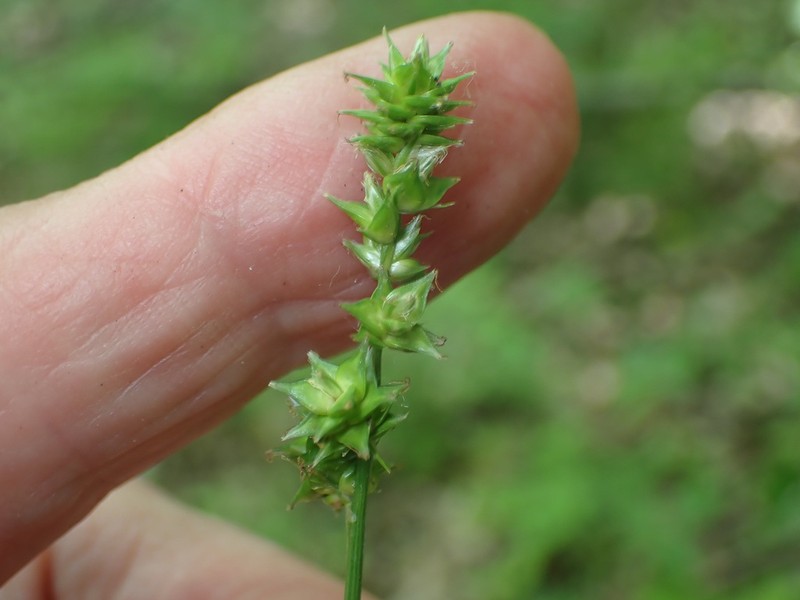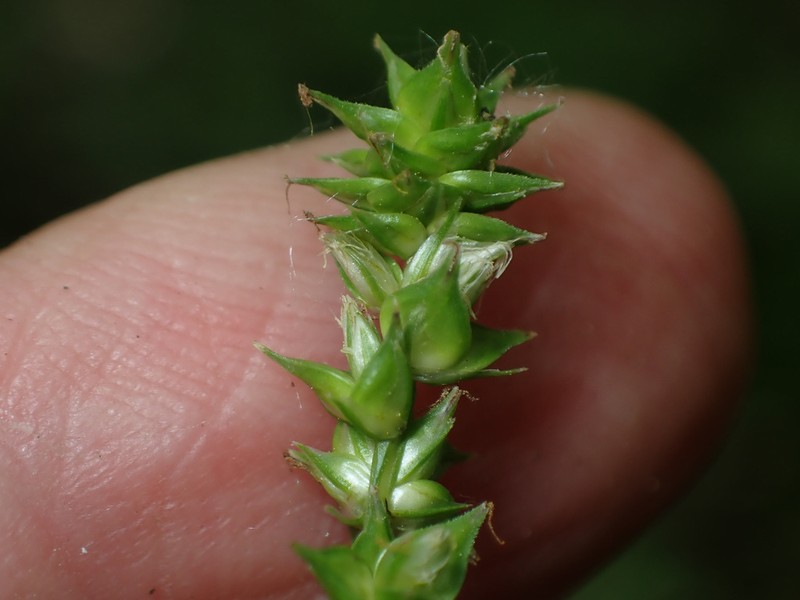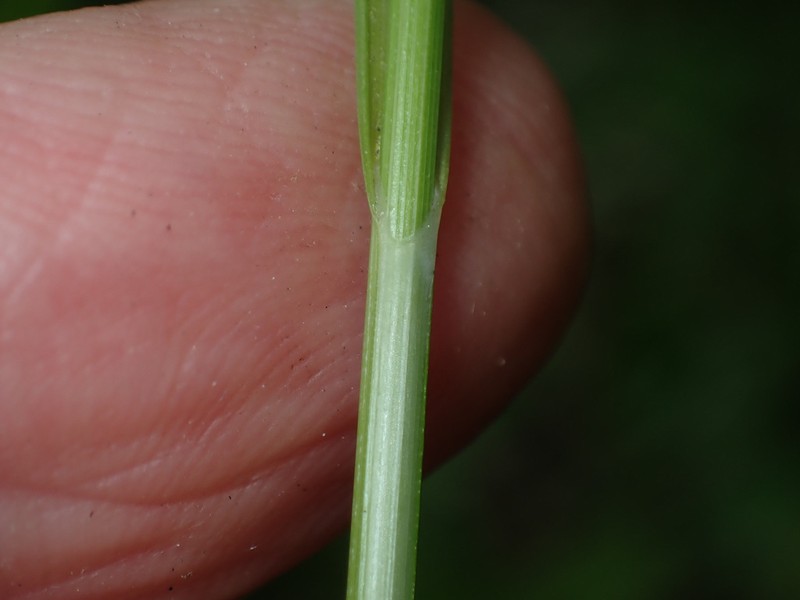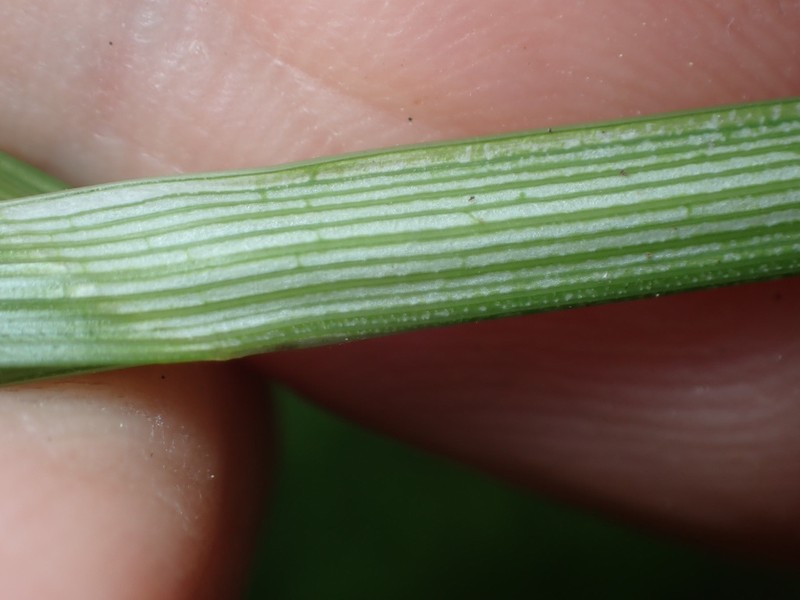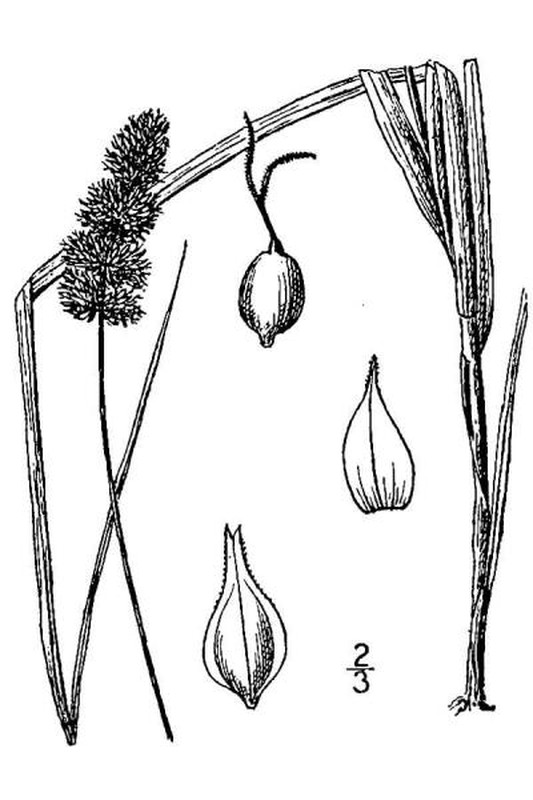Glomerate Sedge
Carex aggregata Mackenzie
- Class
- Monocotyledoneae (Monocots)
- Family
- Cyperaceae (Sedge Family)
- State Protection
- Threatened
Listed as Threatened by New York State: likely to become Endangered in the foreseeable future. For animals, taking, importation, transportation, or possession is prohibited, except under license or permit. For plants, removal or damage without the consent of the landowner is prohibited.
- Federal Protection
- Not Listed
- State Conservation Status Rank
- S2
Imperiled in New York - Very vulnerable to disappearing from New York due to rarity or other factors; typically 6 to 20 populations or locations in New York, very few individuals, very restricted range, few remaining acres (or miles of stream), and/or steep declines.
- Global Conservation Status Rank
- G5
Secure globally - Common in the world; widespread and abundant (but may be rare in some parts of its range).
Summary
Did you know?
A different sedge species (Carex gravida) was reported from New York for many years but specimens formerly identified as such were determined to be misidentifications of C. aggregata and/or C. sparganioides. This led to the removal of C. gravida from the checklist of New York State plants.
State Ranking Justification
There is only one known population within New York, however a subsequent survey to this site was not able to relocate this population. The original report indicates this was a very small population. This population needs further survey work. Fewer than five populations have ever been reported from New York which is at the northeastern edge of this sedge's range. Tony Reznicek, University of Michigan and Flora of North America Carex author, has seen and verified the identity of the only known New York population.
Short-term Trends
There is only one known population that has been seen within the past 20 years. An attempt at relocating this population was unsuccessful but there was more habitat to search. Overall short term trends are unknown.
Long-term Trends
All but one population have not been seen in over 20 years. Searches to these historical populations have not been conducted and it is unknown if these populations are still extant. Therefore, long term trends are unknown.
Conservation and Management
Threats
One population is known from a cemetery. The impacts of cemetery management are not known, but it may be useful to monitor the impacts or benefits of mowing and other management activities.
Conservation Strategies and Management Practices
Information about the one population known from a cemetery as well as conservation concerns need to be communicated to the owners of the property.
Research Needs
Surveys to historical occurrences are needed. In addition, one population that was seen in 1988 needs to be relocated and surveyed.
Habitat
Habitat
Sandy soils in a cemetery and rich woods (New York Natural Heritage Program 2006). Meadows, thickets, open forests, usually on calcareous soils (Ball 2002). Moist woods, meadows, and ditches (Rhoads and Block 2000). Dry clearings of an open hackberry forest over shallow limestone soils (Oldham and Crins 1988). Rich woods, thickets, and meadows (Fernald 1970).
Associated Ecological Communities
- Limestone woodland*
(guide)
A woodland that occurs on shallow soils over limestone bedrock in non-alvar settings, and usually includes numerous rock outcrops. There are usually several codominant trees, although one species may become dominant in any one stand.
- Successional old field*
A meadow dominated by forbs and grasses that occurs on sites that have been cleared and plowed (for farming or development), and then abandoned or only occasionally mowed.
- Successional shrubland*
A shrubland that occurs on sites that have been cleared (for farming, logging, development, etc.) or otherwise disturbed. This community has at least 50% cover of shrubs.
* probable association but not confirmed.
Range
New York State Distribution
There have only been a few populations ever reported from New York. These are scattered from the southern tier of western New York, through central New York, and into southeastern New York including Long Island.
Global Distribution
Carex aggregata occurs from New York west to southern Ontario, Michigan (probably adventive), Minnesota, and South Dakota south to North Carolina, Tennessee, Alabama, Missouri, and Oklahoma (Voss 1972, Oldham and Crins 1988, Ball 2002).
Identification Comments
General Description
Carex aggregata is a tufted, perennial, grass-like plant. It has long strap-like leaves that are up to 3.5 to 5.0 mm wide. From the tufts of leaves at the base of the plant, a stem 20-100 cm tall arises. Leaves come off of this stem and at the top of the stem is a dense cluster of flowers/fruits. The flower/fruit cluster is 1.5-5 cm long, 8-13 mm wide, and contains many numerous, small, and inconspicuous flowers. Small (3.4-4.6 mm long) green fruits (perigynia) form from the flowers (Ball 2002).
Identifying Characteristics
Carex aggregata is a cespitose perennial. The rhizomes are inconspicuous. Culms are (20-) 30-100 cm long. Leaf sheaths are usually loose with the fronts hyaline and the summit of the fronts yellow or brown and thickened. The backs of the proximal leaf sheaths are green and white striped and mottled with conspicuous cross veins. Leaf blades are up to 3.5-5 mm wide. The ligules are shorter than to as long as wide. There are 5-10 androgynous short spikes densely clustered on the top (1.5-) 2-5 cm of the culms. Pistillate scales are 2.2-3.5 mm long, acuminate to short-awned, and the bodies of the scales are 0.67 times to almost as long as the perigynia. The anthers are 1.5-2.5 mm long (Ball 2002).
Best Life Stage for Proper Identification
Carex aggregata is easiest to identify when it is in mature fruit but the fruits are not yet easily shedding.
Similar Species
There are three other members of Carex section Phaestoglochin (C. sparganioides, C. cephaloidea, and C. gravida) that are similar.
Carex sparganioides is perhaps the most different from C. aggregata of these three. It has a more elongated inflorescences (3-15 cm long) with a larger proximal internode. In addition the widest leaf blades are 5-10 mm wide (Ball 2002).
Carex cephaloidea is the most similar to C. aggregata of the species that occur in New York. Carex cephaloidea has the widest leaf blades (4-)5-8 mm wide and the ligules are just longer than wide. In addition, the pistillate scales are 1.5-2 mm long, subobtuse to acute, and the bodies are no more than 0.5 times the length of the perigynia (Ball 2002). Mackenzie (1906) in his description of C. aggregata (as C. agglomerata) used culm scabrousity to separate C. cephaloidea and C. aggregata. The angles of the culms of Carex cephaloidea being strongly serrulate while those of C. aggregata are only roughened just below the inflorescence. These character states may be incorrect or subtle.
Carex gravida does not occur in NY but was attributed to the state incorrectly in the past (Mitchell and Tucker 1997, Mitchell 1998). It is not expected in the state. Carex gravida mainly differs in having the summit of the leaf sheath fronts white, hyaline, not thickened, and fragile (Ball 2002).
Best Time to See
Carex aggregate is in just immature to mature fruit that are not easily shedding from June through early July. Therefore surveys are most successful if conducted during this time period.
- Fruiting
The time of year you would expect to find Glomerate Sedge fruiting in New York.
Glomerate Sedge Images
Taxonomy
Glomerate Sedge
Carex aggregata Mackenzie
- Kingdom Plantae
- Phylum Anthophyta
- Class Monocotyledoneae
(Monocots)
- Order Cyperales
- Family Cyperaceae (Sedge Family)
- Order Cyperales
- Class Monocotyledoneae
(Monocots)
- Phylum Anthophyta
Additional Common Names
- Sedge
Synonyms
- Carex agglomerata Mackenzie
- Carex sparganioides var. aggregata (Mack.) Gleason
Comments on the Classification
Carex aggregata is in section Phaestoglochin. This section had previously been lumped under section Bracteosae which is now considered a distinct section from Central and South America (Ball 2002). Specimens previously identified as C. gravida from NY were misidentifications of C. aggregata or C. sparganioides (Mitchell 1998).
Additional Resources
Best Identification Reference
Ball, P.W. 2002. Carex Linnaeus sect. Phaestoglochin Dumortier. Pages 285-297 in Flora of North America Editorial Committee (editors), Flora of North America, north of Mexico, Volume 23, Magnoliophyta: Commelinidae (in part): Cyperaceae. Oxford University Press, New York, New York, USA. 608pp + xxiv.
Other References
Fernald, M.L. 1950. Gray's manual of botany. 8th edition. D. Van Nostrand, New York. 1632 pp.
Gleason, Henry A. and A. Cronquist. 1991. Manual of Vascular Plants of Northeastern United States and Adjacent Canada. The New York Botanical Garden, Bronx, New York. 910 pp.
Holmgren, Noel. 1998. The Illustrated Companion to Gleason and Cronquist's Manual. Illustrations of the Vascular Plants of Northeastern United States and Adjacent Canada. The New York Botanical Garden, Bronx, New York.
Mackenzie, K. K. 1906. Notes on Carex I. Bulletin of the Torrey Botanical Club 33: 439-443.
Mitchell, R. S. 1998. Amendments to the State Checklist I. New York Flora Association Newsletter 9(3): 1-2.
Mitchell, Richard S. and Gordon C. Tucker. 1997. Revised Checklist of New York State Plants. Contributions to a Flora of New York State. Checklist IV. Bulletin No. 490. New York State Museum. Albany, NY. 400 pp.
New York Natural Heritage Program. 2010. Biotics database. New York Natural Heritage Program. New York State Department of Environmental Conservation. Albany, NY.
New York Natural Heritage Program. 2024. New York Natural Heritage Program Databases. Albany, NY.
Oldham, M. J., and W. J. Crins. 1988. New and significant records of Ontario sedges (Cyperaceae). Canadian Field-Naturalist 102(3):500-507.
Reschke, Carol. 1990. Ecological communities of New York State. New York Natural Heritage Program, New York State Department of Environmental Conservation. Latham, NY. 96 pp. plus xi.
Rhoads, Ann F. and Timothy A. Block. 2000. The Plants of Pennsylvania, an Illustrated Manual. University of Pennsylvania Press, Philadelphia, PA.
Voss, E.G. 1972. Michigan Flora, Part I. Gymnosperms and Monocots. Cranbrook Institute of Science Bulletin 55 and the University of Michigan Herbarium. Ann Arbor. 488 pp.
Weldy, T. and D. Werier. 2010. New York flora atlas. [S.M. Landry, K.N. Campbell, and L.D. Mabe (original application development), Florida Center for Community Design and Research http://www.fccdr.usf.edu/. University of South Florida http://www.usf.edu/]. New York Flora Association http://newyork.plantatlas.usf.edu/, Albany, New York
Links
About This Guide
Information for this guide was last updated on: November 4, 2022
Please cite this page as:
New York Natural Heritage Program. 2024.
Online Conservation Guide for
Carex aggregata.
Available from: https://guides.nynhp.org/glomerate-sedge/.
Accessed July 26, 2024.
